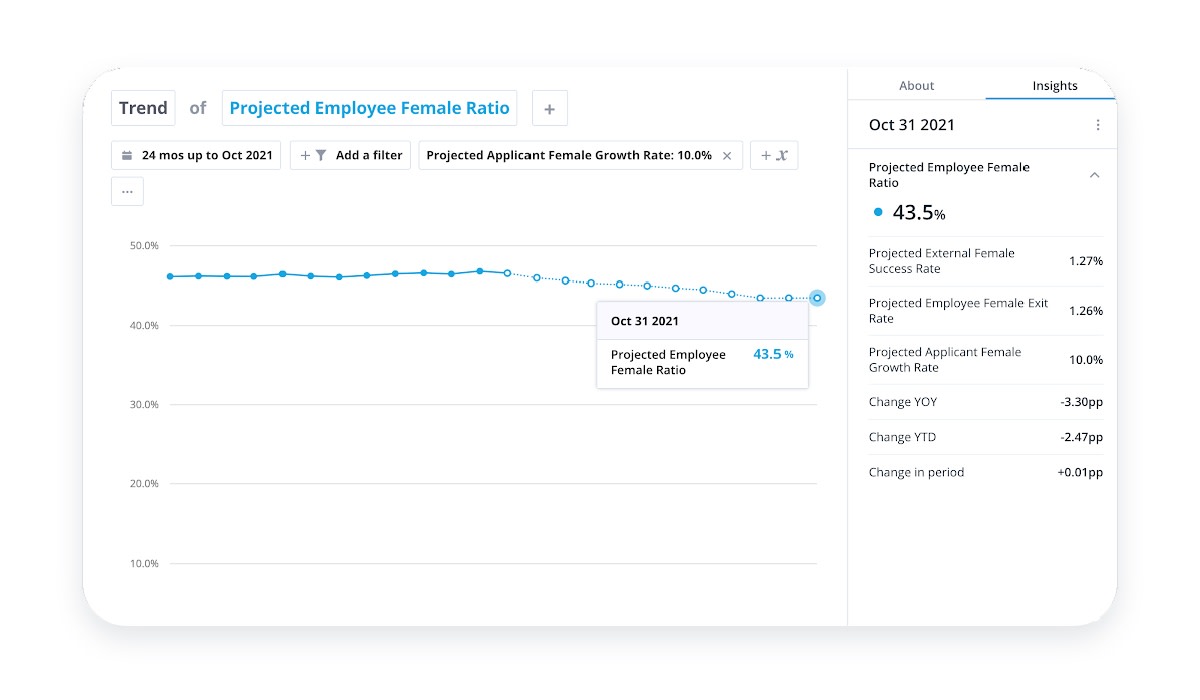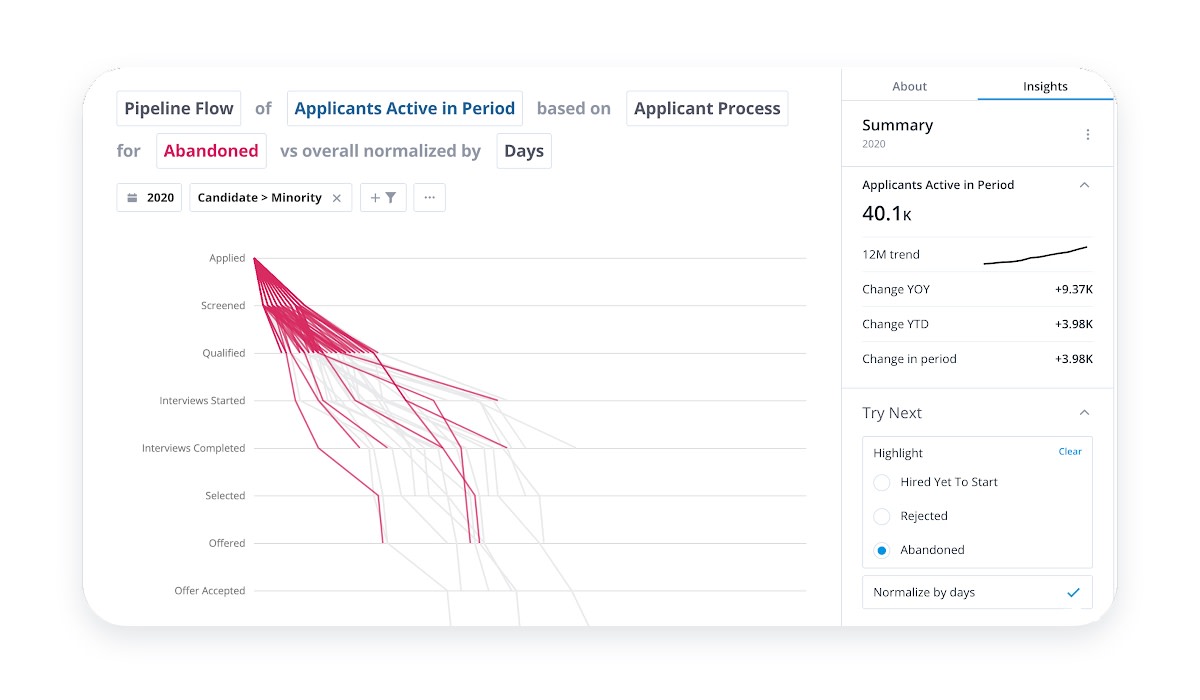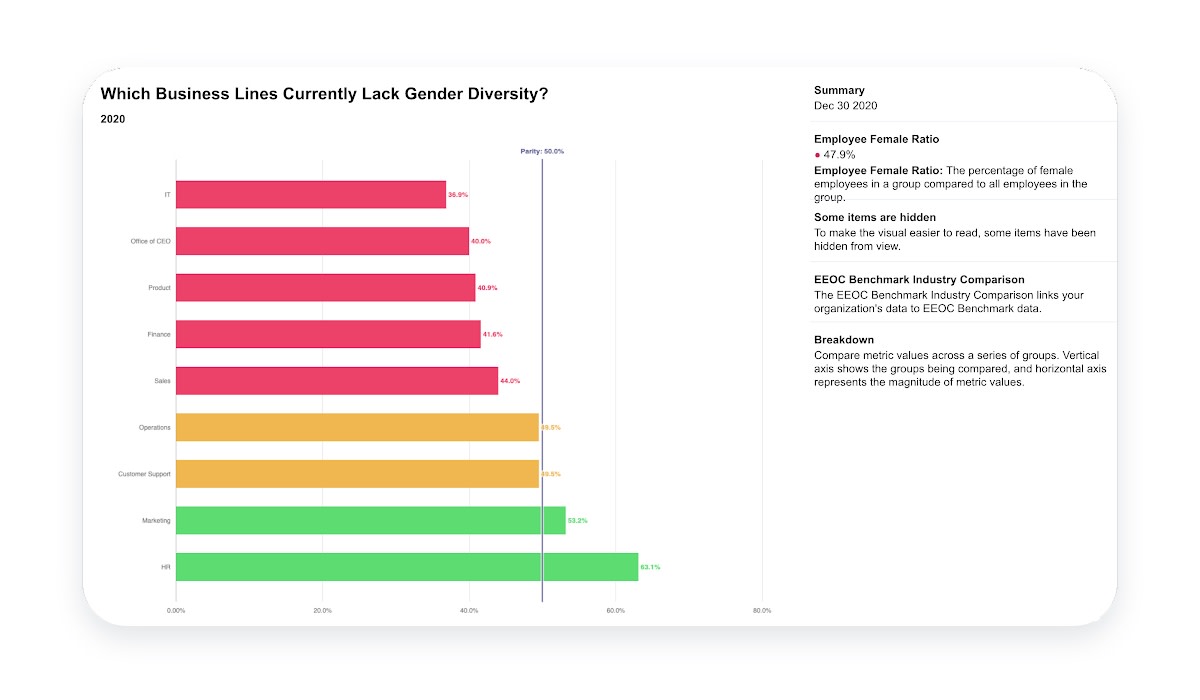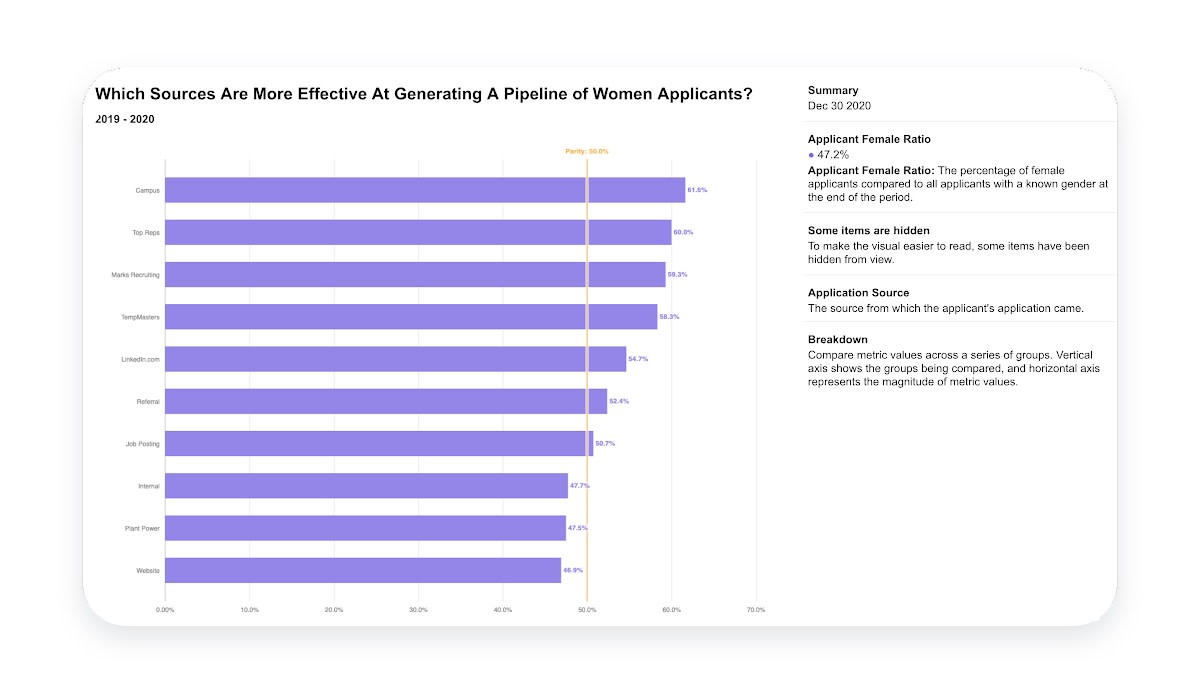The 3 A’s for Recruiting More Diverse Talent
Creating more diverse teams starts with hiring more diverse candidates. Ask, align, and act to address issues in your recruiting funnel.

Companies often have best of intentions when it comes to diversity, equity, inclusion, and belonging (DEIB)—beginning with hiring. However, many companies have found it incredibly difficult to make good on their pledges of hiring, promoting, and keeping diverse candidates. What’s holding them back?
Often, they simply don’t know where they currently stand in regards to DEIB metrics, let alone where they need to go. Companies who are serious about realizing the promises they’ve made to their people are tracking metrics and analyzing data to measure progress, even if that progress isn’t as fast as they’d like.
An example of how data analytics leads to better DEI outcomes is Snap Inc, parent company of Snapchat. Snap used data and analytics to keep a close eye on diversity at their organization. The organization then set ambitious goals for a profound impact on diversity among their people.
“We have really lofty hiring goals,” explained Kami Tilmann, Head of Data Science and People Analytics at Snap. “We understand that we have a long ramp ahead of us, so it’s important that we weave DEI into everything we do.”
Forward-thinking organizations like Snap understand that to create more diverse teams, you need to hire more diverse candidates. That puts Talent Acquisition (TA) teams and their processes at the forefront of the battle for ethnic and gender parity.
Ask, Align, Act for better workforce DEIB
Implicit bias inevitably creeps in during the hiring process when we rely on intuition or assumptions. This is true in many other workplace scenarios as well. And of course, without elements in place to keep and promote diversity, even hiring sufficient numbers of diverse candidates simply creates a revolving door of talent. There’s no real change until organizations act based on research and data.
But there is hope. Talent acquisition teams can use Visier to better understand diversity in their applicant funnel, identify the root causes behind them, and involve the rest of their colleagues in taking corrective action. This strategy for recruiting talent with diversity, equity, and inclusion in mind falls into three steps: Ask, Align, Act.
Ask: Investigate the current state of DEI in your talent pipeline

The first move is to assess all of your data so you can see the full picture and get a better sense of where your organization is meeting or falling short of your goals. Rely on data, not hunches—your TA funnel’s strengths and weaknesses when it comes to diversity are likely not where you expect.
Here are some questions that you can answer with Visier. Asking these questions will help you assess the diversity of your candidate funnel and uncover where diverse applicants are dropping out. If you lose diverse candidates in the funnel because they’ve had a poor candidate experience, you’ve wasted all your work attracting them.
How much farther from your goals will you be in the future if you took no action?
How would taking one specific action (such as increasing women hired by 10%), affect progress towards equity?
At what point in your pipeline are diverse applicants dropping out?
Which sources of applications are bringing you the most diverse candidates?
Are you prioritizing these sources?
How do turnover rates for diverse new hires compare to new hire turnover benchmarks?
What are your engagement rates with candidates from historically excluded groups?
Are there any noticeable differences when you filter by organization, hiring manager or job level?

Understanding this data lays the foundation for understanding DEI issues within your applicant funnel. Next, you and your team need to examine it together. Keep an open mind—sometimes unexpected weaknesses may feel uncomfortable.
Align: Brainstorm solutions with your entire team

In the first stage, you used data to create a clear picture of your organization’s strengths and weaknesses when it comes to TA diversity. In the second stage, you looked for solutions. Now, it’s time to share those findings with the people doing the bulk of the talent acquisition—your recruiters and hiring managers.
Allowing recruiters and hiring managers to weigh in with their real-life knowledge can contextualize the data you’ve uncovered. They’ll be able to validate what you’ve found and possibly provide insight into any confusing anomalies. If the data discoveries contradict existing pre-conceptions, listen without judgment. Then return to the data together, collaborating to find the root causes behind trends and problems and understand why your results differed from what you expected to see.

Here’s an example of how you could work with your team to explore TA data at the Align stage.
If specific business lines that are lacking in gender diversity, you could adjust candidate sources for those departments and increase the pipeline funnel.
Find out which applicant sources generate the most female, transgender, and non-binary applicants, and uncover the success rate of candidates from those sources.
Examine whether hiring managers’ and recruiters’ gender influences how many women, transgender, and non-binary applicants made it to the hiring stage.
Act: Share your findings with stakeholder groups and get ready to translate them into action
After you’ve reached a solid understanding of which areas in your recruiting funnel need improvement—and you’ve got the data to back it up—it’s time to share them with stakeholder groups, and get ready to organize people for action.
Create a strong, compelling presentation that tells everyone the story of the state of your TA process, where the issues lie, and why it’s so crucial that you act now. This will illustrate your findings in an easy-to-understand way.
Start with an introduction that explains the current state of your hiring process in regards to DEI, then move into explaining the problem with as much detail as possible. This creates the necessary foundation to act on this data.
Here are some examples of steps you can take to address the problems you’ve uncovered:
If some applicant sources provide a more diverse group of applicants than others, increase your efforts on those stronger sources and decrease your reliance on less effective ones.
If you have successfully attracted qualified candidates from a source, but these candidates aren’t getting hired, investigate the biases of the hiring committees and redact resume information that isn’t relevant to candidates’ qualifications.
If diverse candidates enter the hiring funnel but drop out at a higher rate, evaluate every touchpoint in the hiring process. In your ATS, you can review screening questions, job descriptions, website content, onboarding training, and more to provide a more inclusive, welcoming experience
If your current sources of hire aren’t effective for your diversity strategy, expand the sourcing strategy to include clubs, events, universities, colleges, or trade schools to nurture talent pools of historically excluded groups.
Meeting diversity goals relies on data—and people
Working towards a more diverse, equitable, and inclusive future requires all stakeholders to pull together. But data, and solutions to translate it into action, can help you identify and counteract bias within the hiring process, helping to build a more diverse future.
Using actionable data brings diversity issues into the light, and gives you the data to truly understand what’s keeping you from your DEI goals. The right technology tools can make it easier for teams to stay in contact with, and nurture, the diverse talent they worked so hard to attract. The Ask, Align, Act framework makes it easier to identify, visualize, and address problem areas for diversity within your organization’s hiring process. But it’s up to your people to use it to enact real change.


